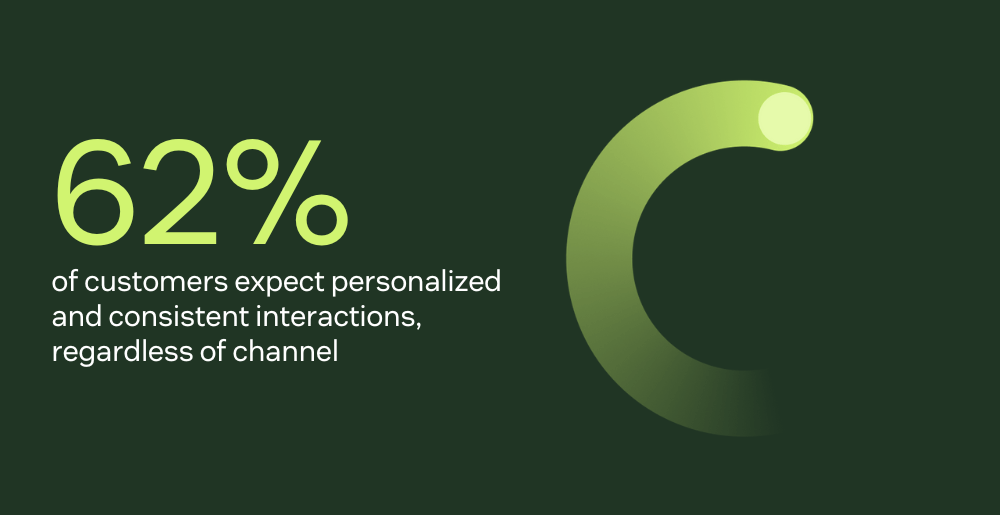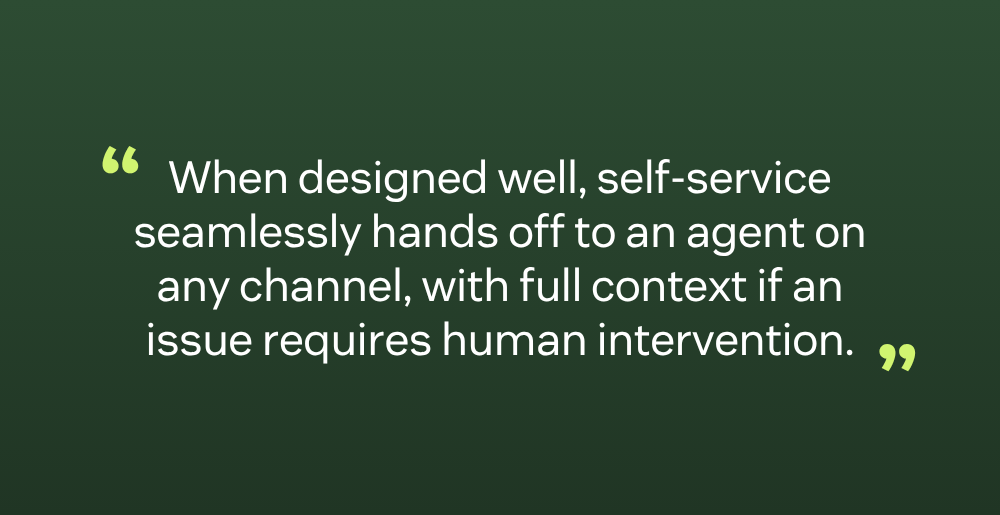Article • 5 min read
Transform your contact center: The power of unified omnichannel and self-service
Unified omnichannel and self-service are the operational backbone for efficiency, agent empowerment, and exceptional customer outcomes.
Hannah Deveney
Senior Director, Product Management at Zendesk
Última atualização em October 16, 2025
Customers expect seamless, personalized service on whichever channel they choose. The era of single-channel support is over; now, it’s a fluid journey across email, chat, SMS, social media, and more. According to Zendesk’s 2025 CX Trends report, 62% of customers expect personalized and consistent interactions, regardless of channel. This impacts every aspect of the contact center.
To keep pace, businesses must dismantle technology silos and invest in systems like advanced routing to ensure customers get to the right agent at the right time. Training must also evolve to focus on a unified agent workspace enabling agents to navigate all channels and seamlessly pick up when self-service falls short. For contact center leaders, meeting these expectations not only delivers a competitive advantage; it directly boosts First Contact Resolution (FCR), drives down Average Handle Time (AHT), and ensures high customer satisfaction.

Simultaneously, the demand for self-service has never been higher. Nearly 70% of customers want to resolve issues on their own. The strategic convergence of a seamless omnichannel presence and robust self-service capabilities is now fundamental to a modern, resilient customer experience strategy. But many businesses struggle with where to begin. So here’s what you need to consider when building an effective omnichannel strategy in the contact center.
4 steps to crafting a high-performing omnichannel strategy for your contact center
Being truly omnichannel extends beyond simply being present on multiple platforms. You need to understand which channels are most important to customers by reviewing existing usage data, exploring industry trends, and assessing competitive offerings. This ensures your business is active where it matters.
I believe it’s also important to note the nuances of different channels, how they behave and how users interact with them. For example, voice is real-time and so seconds matter, whereas asynchronous channels such as chat and email can have longer elapsed time between updates. A successful omnichannel strategy needs to cater for these nuances whilst ensuring a consistent agent experience.
Imagine a customer unable to resolve an issue via self-service AI chat. Their request is seamlessly routed to the correct agent with the knowledge and full context to assist. This illustrates a superior omnichannel approach, managed end-to-end within a unified contact center avoiding the disjointed and frustrating experiences many customers have come to expect.
Based on my experience working with thousands of CX leaders, here are 4 tactics to successfully build an omnichannel strategy:
- Map the customer journey to your channel strategy: Before layering in technology, it’s important to walk in your customer’s shoes. Use journey mapping and analytics to reveal friction points and preferred engagement paths. Crucially, this map will highlight which channels matter most to your customers. Avoid the pressure to be everywhere; focus your presence on channels your customers actively use to reach your contact center. Be available and exceptional where it counts for your audience.
- Unify data, platforms, and systems: Invest in a unified contact center system that can bring everything your agents need into one place. This means integrating your CRM, analytics, AI tools, and apps into a single interface within the contact center. This integrated platform streamlines communication, provides a unified view of customer interactions across all channels, and boosts agent efficiency by eliminating app toggling.
- Speak with one voice, everywhere: Ensure your messaging and tone are perfectly aligned wherever customers connect. This can be achieved by integrating a shared knowledge base directly into the agent workspace, creating standardized response templates, and implementing cross-channel training. If a customer gets a resolution via social media, those details and next steps must also be visible to an agent who interacts later via phone.
- Automate the simple, escalate the complex: Use AI to understand customer intent and use smart routing to direct them to the right solution, without rigid menu trees. This could take the form of deploying AI agents to handle the bulk of the common queries coming into your contact center. This ensures routine inquiries are solved instantly through automation while more nuanced cases are intelligently routed to the best-equipped human agent.
What is the role of self-service in the modern contact center?
Self-service acts as the foundational layer of a great omnichannel experience. It serves as the first port of call, available 24/7 to provide instant answers and empower customers. This immediate access leads to higher satisfaction, as quick and easy problem-solving lets customers resolve issues on their own terms.

When designed well, self-service seamlessly hands off to an agent on any channel, with full context if an issue requires human intervention. This synergy boosts customer satisfaction, streamlines operations, and improves agent productivity by freeing them up for high-value interactions. So what does your business need to implement self-service?
Here are my top tips:
- Build a dynamic knowledge base: Self-service starts and ends with your help center. Ensure it’s comprehensive, easily searchable with natural language, optimized for AI, and continuously updated based on common customer queries.
- Deploy intelligent escalation paths: Start simple by deploying AI agents to handle your most common, repetitive queries. Analyze your contact center data to identify high-volume FAQs like order tracking or password resets. Offloading these tasks frees human agents for more complex issues. Crucially, designing a seamless, one-click handoff to a live agent on the customer’s channel of choice if the bot can’t resolve the issue, ensures queries are resolved smoothly.
- Analyze and iterate constantly: Use analytics to understand what customers are searching for, where they are struggling, and which articles are most effective. Use these insights to identify gaps and continuously improve your self-service content.
The power of the modern contact center
Customers want fast, personal service on the channel of their choice. Businesses want efficiency, loyalty, and measurable returns. Zendesk for Contact Center delivers both.
It unifies voice, SMS, email, and social media into a single platform, powered by AI and agents can see the full history of every interaction. Customers get connected experiences. Agents get efficiency and clarity. Businesses get measurable impact.
These aren’t just technical upgrades. Together, omnichannel engagement and intelligent self-service have become the foundation of a modern customer experience. And organizations that unify channels, empower customers to help themselves, and support agents with AI-powered tools will set the standard for loyalty, efficiency, and growth in the years ahead.
